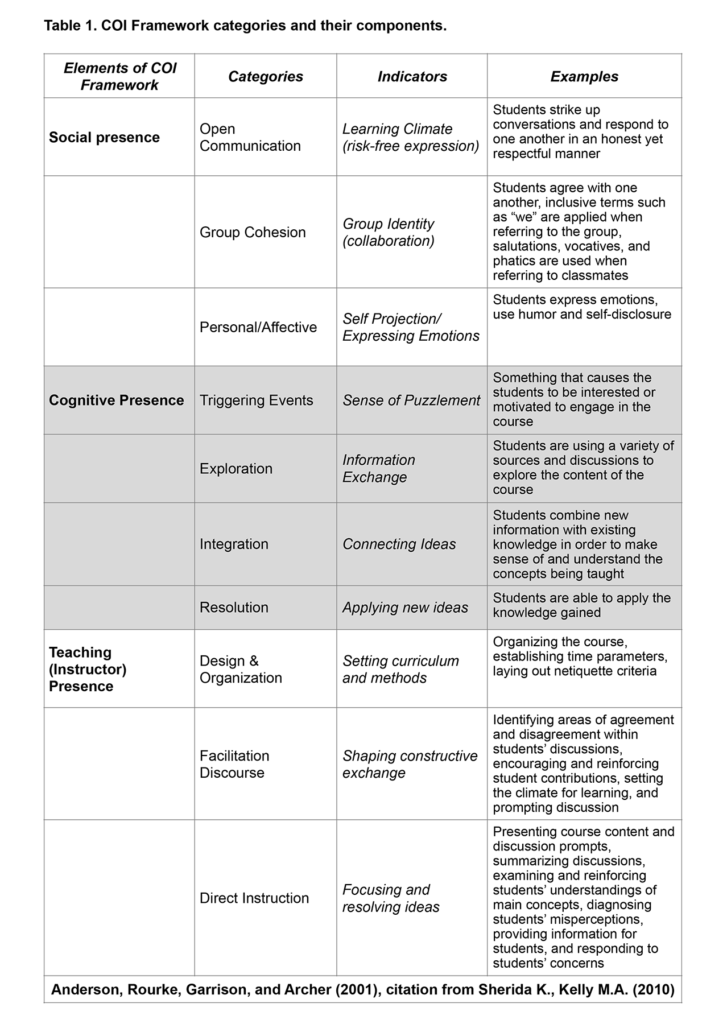10
Lioubov Krasheninnikova
Abstract
A number of methods to humanize online learning environment were applied while delivering an undergraduate business education program. The methods were selected to cover all three components of the Community of Inquiry (CoI) Framework (teaching, social, and cognitive presence). All the methods proved to be affordable for application in the context under consideration. Relations between their application and students’ perception of the learning experience as successful were analyzed based upon a small selection of students. The data points to some positive relations between application of described methods and learning outcomes.
Keywords: Online Learning, Community of Inquiry Framework, Student Perceptions, Virtual Learning Environment Humanization
Introduction
Transition of education process into virtual learning environment (VLE) is now a recognized trend rising much research and innovation (Ko, S. and Rossen, S. 2010; Rice, K., 2011). Having started with K-12 online learning, this trend has now reached higher and post-graduate education.
For education in Russia, with its long distances, this trend can be of special importance. In this chapter, online business education in Russia is considered. Demand for business education in Russia is still high although Russia’s economic situation makes traditional on-campus post-graduate education hardly affordable because of, firstly, poor access to quality education resources (lecturers, textbooks, cases etc.) and, secondly, drop in paying capacity.
Under these conditions possible way out is transmitting learning into virtual learning environment (VLE). This will help to overcome both challenges by:
- Providing access to high-quality lecturers via Internet and
- Decreasing costs for transfer of lecturers to campus.
The last decade Russian institutions started with delivering business education programs via the Internet. Commonly they are confined with placing textbook and other readings on the Internet and providing students access to them. Some attempts of the kind were a success (http://e-learningcenter.ru/) although many other failed. The problem, as it is clear now, was poor theoretical and/or methodological basement of online learning (Palloff, R. M. & Pratt, K., 2003). Many, if not most educators just placed textbooks on the Internet with minimal (if any) presence of the instructor. Later an association of educators began delivering education programs was established (business education among them) online (http://www.openlearning.ru) but it has not affected business education noticeably.
Although shifting education to online is recognized, major part of educators remains in the dark regarding frameworks and/or techniques to realize it. Those delivering mathematics, foreign languages and other disciplines with high demand for skills are more successful while those delivering social sciences, art etc. have poor idea what to do. It refers to both highly ranking universities and, as the author’s personal communications evidence, to newly launched education projects.
Recent research and development in the online education area made it possible to qualitatively improve a virtual learning environment. It’s clear now that it should be humanized (imaginary distance between instructor and students should be shortened), and modern technologies provide such a possibility. To measure the distance such criteria as an immediacy of feedback, clearness of instructions and share of synchronous learning events and others provided by the CoI Model (Garrison, D. R., Anderson, T., & Archer, W., 2000) can be applied.
Such MOOCs as Humanizing Online Instruction provide instructors with chances to develop their skills in online teaching. Having mastered the technologies they can apply them to deliver qualitative education programs with better quality and at lower prices. In this chapter experiences gained at delivering online business education courses with an application of technologies mastered at Humanizing Online Instruction MOOC will be described and analyzed. The course under consideration is “Business Functions in Context” and it is part of higher education in business (bachelor program). Specificity of the class is the long distance between students’ locations. In fact, the class included students from 5 Russian cities from Central Russia (Moscow and Moscow Region) to Western (Tymen) and Eastern Siberia (Krasnoyarsk), distance Moscow-Krasnoyarsk being 4100 km. Besides geographical position, cohorts of students vary by age and managerial experience. Covering all the territory with face-to-face lectures even once a month is not possible, they should be instructed distantly thus online instructions are not only affordable, they are strictly demanded.
Being the instructor, the author designed course delivery so as to achieve students’ perception of learning experience as successful. The author aimed at humanizing virtual learning environment as much as possible via demonstrating instructor presence. Theoretical concepts, as well as technologies, learned at the Humanizing Online Instruction MOOC were of great assistance to achieve this. Of them the Community of Inquiry (CoI) model assuming that Community consists of teachers and students- key participants of the educational process was of special value. Learning occurs within the Community through the interaction of three core components: teaching, cognitive, and social presence (Garrison, D. R., Anderson, T., & Archer, W., 2000). The CoI model proved to be instrumental through providing detailed criteria and judge upon these presences hence its applicability to humanize online instruction at practice (Garrison, D.R. et al, 2010).
Thereby, objectives of the study were to research:
- Appropriateness of earlier described methods to show instructor presence in this certain context;
- Relations between successful learning outcomes and instructor presence;
Humanizing Online Instruction
- Affordability of technologies aimed at instructor presence showing and evaluating their impact on students’ perception of learning experience.
Theoretical Background
For the purpose of the research the author relied on the Community of Inquiry framework (Garrison et al., 2000). This framework is a dynamic model of three overlapping multi-dimensional elements: social, cognitive, and teaching presence. Each presence can be operationally defined in terms of constituting categories (Akyol, Z., Garrison, D.R., 2008) and is provided with indicators making the model operational (Sheridan K., Kelly M.A., 2010).
“Teaching” or “instructor” presence tends to be used in literature as synonyms and can be defined via many indicators. In objectives of the research measuring of the teacher presence was limited to combination of frequency of instructor’s appearance in the community and his (her) communication and interaction styles (Kassinger, 2004). It entails regular posting on the group forum, timely responding to students’ questions and providing feedback (Pallof and Pratt, 2003). In terms of Anderson et al, 2001, teaching presence is aimed at facilitating cognitive and social processes in the community to achieve meaningful and educationally worthwhile outcomes. Indicators of teaching and other presences are listed in Table 1, of them facilitation of discourse is especially important for establishing teaching presence (Mandernach, Gonzales, & Garrett, 2006). Some researchers reported instructor (teaching) presence had impact on students’ perception of learning outcomes as successful (Pawan et al., 2003) although other found conflicting results (Wise et al., 2004).
“Cognitive” presence refers to the degree to which learners construct and confirm meaning through discourse and reflection (Swan et al., 2008). Cognitive and teaching presence are highly related: to have students be cognitively engaged in the course it should be properly designed and delivered by the instructor (Shea and Bidjerano, 2009). These authors also reported teaching presence as a primary catalyst to form both cognitive and/or social presence of students. Cognitive presence is considered as a process starting with a triggering event and then, through exploration, integration, and resolution it completes with students’ ability to apply knowledge gained.
“Social” presence refers to students’ feeling of connectedness, both socially and emotionally, with others in the online environment (Swan, et al., 2008). Instructor assistance with student discussions and conversations is reported to be important for establishing a clear teaching presence in the online environment and that this presence was positively related to students’ perceptions of support and inclusiveness (Shea et al., 2005). Positive relationships between instructor presence and students’ sense of classroom community were reported by Shea et al (2006).
Interrelations between these components of the Community of Inquiry framework and their impact on learning outcomes and students’ satisfaction are considered to be complex and, sometimes, equivocal (Hong, K.S. et al., 2003). As Garrison, Anderson, & Archer (2000) have shown, social and cognitive presences are necessary to develop a learning community, they are not sufficient to guarantee desired learning outcomes. This finding is supported by Akyol and Garrison (Akyol, Z., Garrison, D.R., 2008) who have shown cognitive and teaching presences to impact students’ learning and satisfaction. Besides, the three elements appear to develop and progress in different ways in an online learning environment. Indicators of cognitive presence appear to stay steady over time while those of social and teaching presence changed (Akyol, Z., Garrison, D.R., 2008). Thus to guarantee desired learning outcomes all the three components of the COI framework should be designed and integrated to achieve compliance with the learning experience context.
In this chapter intuitively designed and integrated CoI components were found to facilitate learning and to achieve students’ learning, educative, professional, etc. objectives. Initially based on sufficient (11 years) author’s experience in tutoring Open University Business School (OUBS) education programs and in designing OUBS courses (the author was an OUBS Course B716 “Management in Action” Critical Reader), this approach well complied with learning context described above.
Methodology
Research model applied was the Community of Inquiry model as it was described by Garrison, D. R., Anderson, T., & Archer, W. (2000). The strength of this model, among others, is its instrumentality: almost any aspect of the model can be designed and/or measured. On the other hand, limitation to this single model can hinder understanding processes in the online students’ group.
To design COI, a number of tools and methods intuitively extracted by the author from her tutoring experience were applied.
Being categorized according to COI Framework, they look as follows (Table 2):
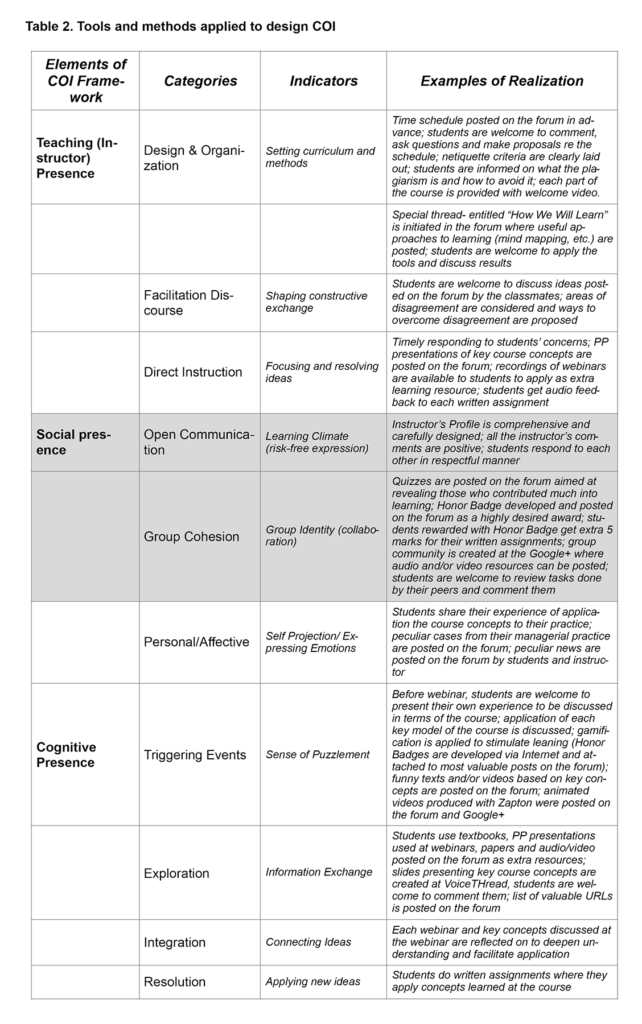
Table 2. Tools and methods applied to design CoI
Methods to evaluate impact of CoI components on students’ learning success and/or satisfaction and students’ perception of instructor presence and learning experience as successful were random and not systemic: evaluation was based on feedback from students obtained from time to time. To judge upon affordability of technologies, impact of the instructor presence on students’ perception of learning frequency of getting feedback and its emotionality was evaluated. To judge upon impact of instructor presence on learning results grades of the students’ written assignments were applied. These data are easily available for tutor hence their value for research. On the other hand, these two methods may be insufficient to judge upon such complicated matter as students’ satisfaction.
Sampling included two groups of students who learned the course (“Business Functions in Context”) either in February – November 2014 or in February – November 2015. The time period was long enough to build CoI but sampling is two limited to make deep conclusions (Tabatabaei, M., et al., 2006).
Discussion
As it is obvious from the Table 2, methods applied clearly demonstrate that all the CoI Framework components were successfully designed and implemented. Teaching presence as well as social and/or cognitive presences were built into learning process and contributed to achieving learning objectives.
In this chapter humanization of learning environment was achieved via application of following technologies (Table 3):
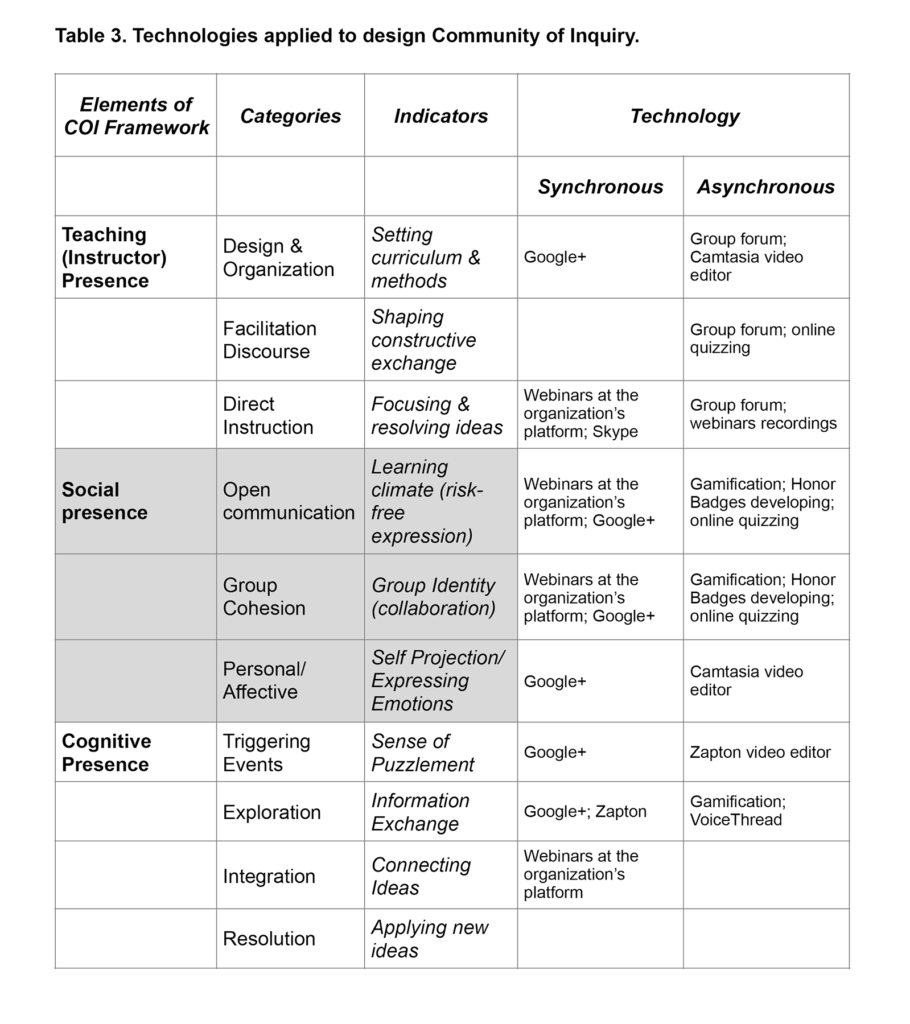
Table 3. Technologies applied to design Community of Inquiry.
Affordability of group forums based on the platform specially designed to support asynchronous online communications of students was not at all a problem (not accounting for the initial login which can require some digital literacy skills).
Google+ could be a challenge as not all students have an account on www.google.com. The same is with the VoiceThread, where in order to comment on the slides students should create an account. For students who are not involved in the Internet, it can be unusual and cause some strain.
Webinars are now quite affordable and ordinary in Russia although reliability and capacity of communication channel could sometimes be better. Video/audio editors are still unfamiliar to students and major part of instructors hence requirements for high instructor’s qualification. Audio feedback to written assignments is quite new for students who learn business in Russian. Gamification is a new trend in management and management learning, although developing and/or application of Honor badges is unfamiliar to business educators hence requirements for high instructor’s qualification once again.
Quizzing design and integration into educator’s site are now available at a number of Internet resources although have not become an ordinary practice so far. Judging by feedback obtained from students, their perception of the learning experience as successful was impacted by:
- Audio feedback on written assignments. Being something extraordinary and thoughtful, it caused the feeling of instructor social and teaching presences, inspired further learning, and increased students’ satisfaction. Due to the availability of audio/video editors (many of them are free) this strategy is highly recommended;
- Gamification via awarding Honor Badges inspired students to keep higher learning standards. Nature of gamification as an education tool is rather complicated hence instructors can be advised to take some MOOC to improve their gamification skills;
- Quizzing aimed at revealing “learning heroes” – students contributing much to the learning of others – was perceived as quite new and appreciated by students;
- Perception of VoiceThread highly depended on the student’s literacy of the Internet. Those skilled in managing their personal data were greatly inspired with this resource as new and fruitful. They commented on the slides, developed their own ones and –even –made proposals regarding VoiceThread applications in their practice;
- ‘Ordinary webinar’ in Russia have become a lecture delivered via the Internet (“head speaking”, or “talking head”) and does not impact on students’ perception of learning as successful. To overcome perceiving of webinars as dull and plain, webinars were improved by installing much interactivity (e.g., polling students on the realization of course concepts in their managerial practice, quizzing etc.). Ideally, webinars should be re-formed into, say, ‘weburials’ (web-tutorials) including sub groups creating, working in subgroups and further joining them for ‘plenary sessions’ to exchange results. The Blackboard Collaborate platform provides such possibilities hence desirability to apply this or similar resources. Application of tools with the possibility to make recordings and making them available to students is crucial as covering special needs students (having poor access to the Internet) and/or those not attending “live webinars.”
- Easy access of the tutor and immediacy of tutor’s reply to their questions.
The relation between perception of the learning experience as successful and/or instructor presence as constructive and facilitating learning could be revealed by comparison learning outcomes of students who expressed inspiration from instructor presence and actively participated in their applications and those who did not.
For February 2014 (14B) presentation of the course dispersion of grades awarded to written assignments was as follows (Table 4 and Picture 1).
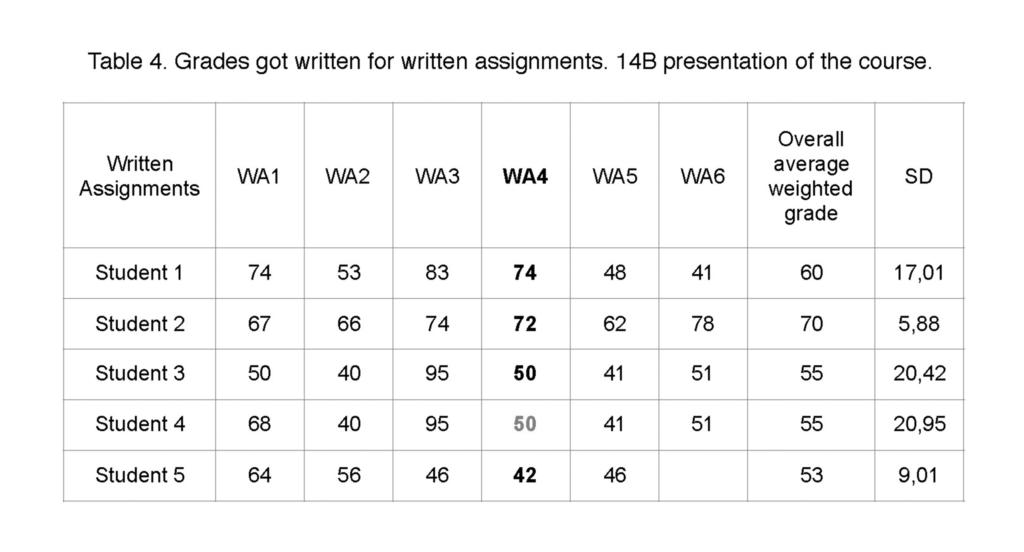
Table 4. Grades got for written assignments presentation 14B (February 2014)
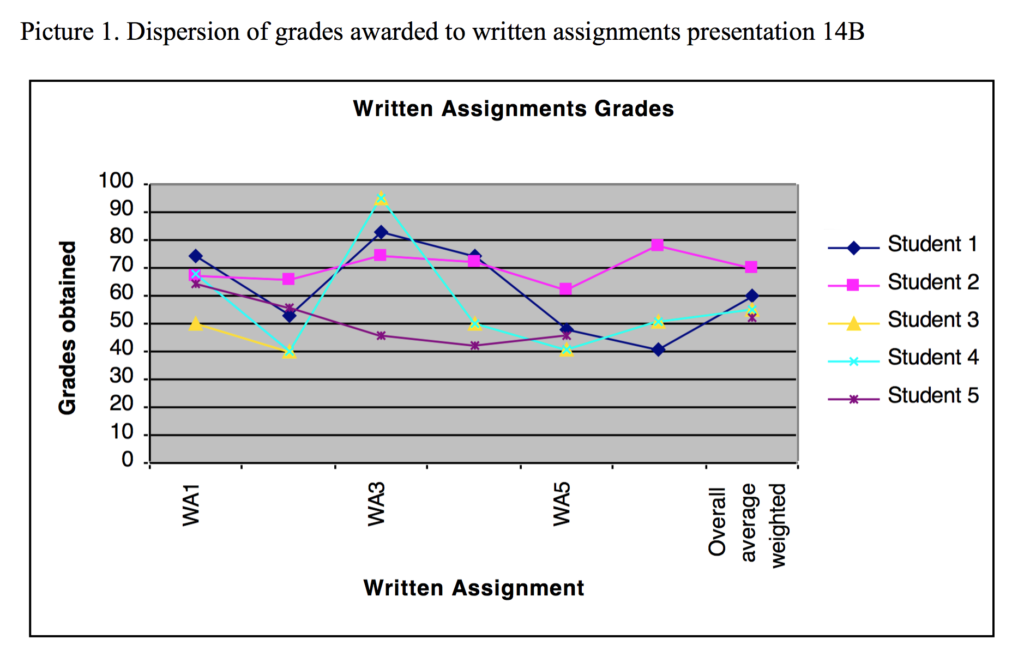 Picture 1. Dispersion of grades awarded to written assignments presentation 14B (February 2014)
Picture 1. Dispersion of grades awarded to written assignments presentation 14B (February 2014)
As it can be seen from Table 4 and Picture 1, Student 2 was the most successful one, his grades were stable and high throughout all the course. At the same time, this student was the most active in using learning technologies (attending webinars, posting on the forum and Google+, providing feedback and case study based on the student’s practice).
Another course presentation was 15B (February 2015), grades obtained by students are presented in Table 5 and Picture 2.
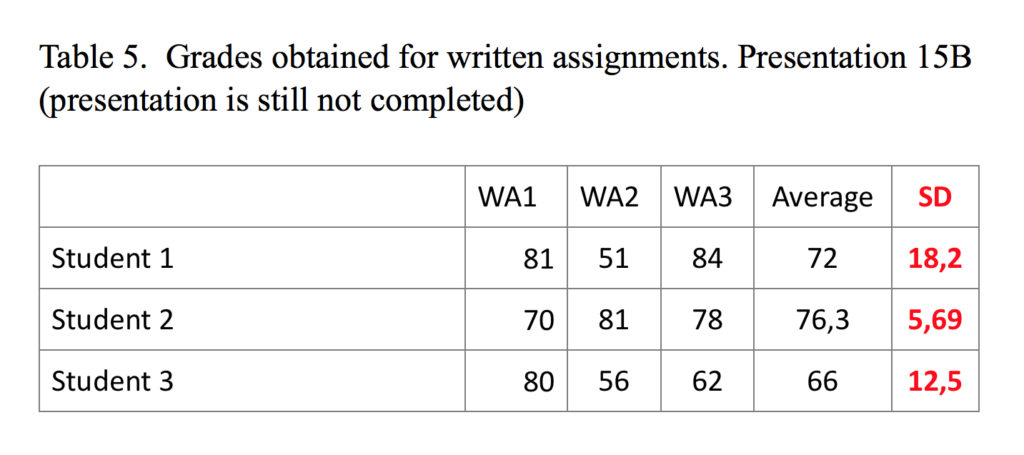 Table 5. Grades obtained for written assignments. Presentation 15B (presentation is still not completed)
Table 5. Grades obtained for written assignments. Presentation 15B (presentation is still not completed)
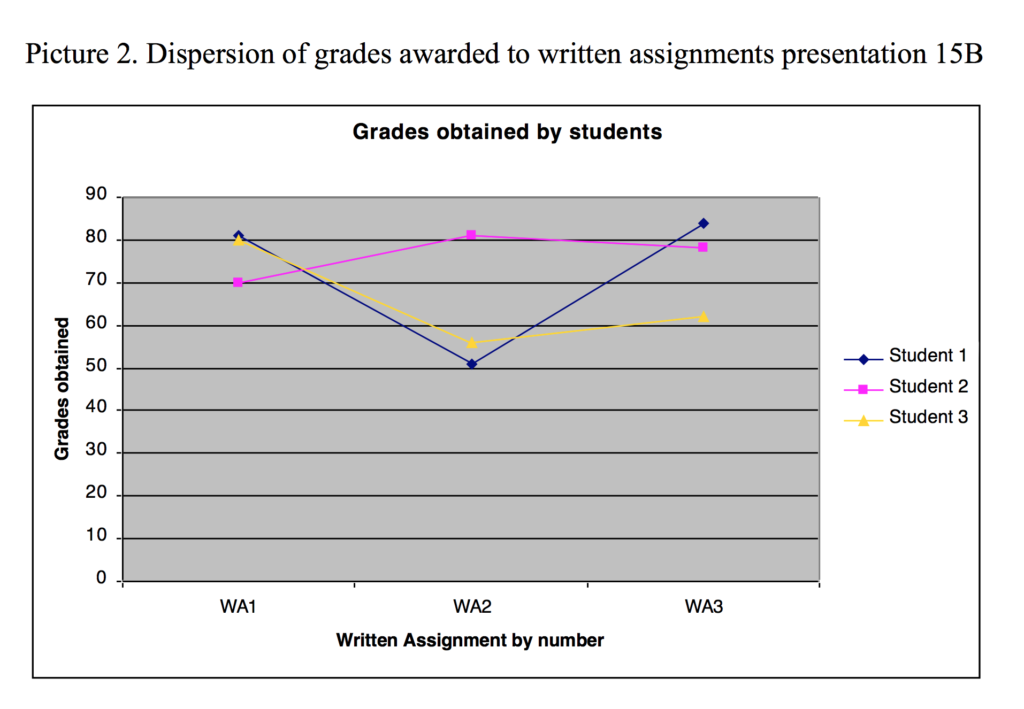 Picture 2. Dispersion of grades awarded to written assignments presentation 15B
Picture 2. Dispersion of grades awarded to written assignments presentation 15B
Of 15B students’ cohort, Student 2 seems to be the most successful and he is the most active in application of methods used (the student was awarded Honor Badge for his contribution into learning; he applied the use of webinars to train salesmen at his workplace and reported improvement of staff relations after them; he gave very warm feedback regarding the instructor’s use of audio comments on his written assignments, etc. Assignments written by Student 2 earned the highest marks.
Conclusion and Future Research
Data obtained is not substantive evidence of positive relations between instructor presence and/or its components and successful learning outputs. Sampling of students and/or written assignments is too little to support this idea. Feedback regarding perceptions of instructor presence as constructive had to be more systematic and comprehensive.
Feedback obtained from students concerning their perception of distance between them and tutor evidence that teaching, cognitive, and social presence of the tutor helped to create virtual learning experiences that are much more humanized compared to the ordinary learning experiences applied by other education organizations in Russia. “Humanization” in this research is interpreted in terms of tutor-students and student-student distances.
Nevertheless, findings of this research can be used to further the research regarding the impact of online learning environment humanization upon students’ perception of learning process and outputs as successful. Recommendations of this study being accounted (systematic collection of data, re: students’ satisfaction as well as perceiving learning experience) this direction of study could have contributed much into understanding and/or improving online learning.
References
Anderson, T., Rourke, L., Garrison, R., & Archer, W. (2001). Assessing teaching presence in a computer conferencing context. Journal of Asynchronous Learning Networks, 5(2).
Akyol, Z., Garrison, D.R. (2008). The Development of a Community of Inquiry Over Time in an Online Course: Understanding the Progression and Integration of Social, Cognitive and Teaching Presence. Journal of Asynchronous Learning Networks, Volume 12: 3-4.
Garrison, D. R., Anderson, T., & Archer, W. (2000). Critical inquiry in a text-based environment: Computer conferencing in higher education. The Internet and Higher Education, 11(2), 1–14
Garrison, D. R., Cleveland-Innes, M., & Fung, T. S. (2010). Exploring causal relationships among teaching, cognitive and social presence: Student perceptions of the community of inquiry framework. The Internet and Higher Education, 13, 31 – 36.
Hong, K. S., Lai, K. W., & Holton, D. (2003). Students’ satisfaction and perceived learning with a web-based course. Educational Technology & Society, 6(1), 116–124.
Humanizing Online Instruction MOOC, CN1701 HUMANMOOC. Retrieved from https://learn.canvas.net/courses/503/modules
Kassinger, F. D. (2004). Examination of the relationship between instructor presence and the learning experience in an asynchronous online environment (Doctoral dissertation). Retrieved from http://scholar.lib.vt.edu/theses/available/etd-12232004-230634/unrestricted/Kassingeretd.pdf
Ko, S. and Rossen, S. (2010), Teaching Online: A Practical Guide, 3rd Edition (ISBN 978-0415997263)
Mandernach, B. J., Gonzales, R. M., & Garrett, A. L. (2006). An examination of online instructor presence via threaded discussion participation. Journal of Online Learning and Teaching, 2(4), 248–260.
Palloff, R. M. & Pratt, K. (2003). The virtual student. A profile and guide to working with online learners. San Francisco: Jossey-Bass.
Pawan, F. Paulus, T., Yalsin S. & Chang, C. (2003). Online learning: Patterns of engagement and interaction among in-service teachers. Language Learning & Technology, 7(3), 119–140
Rice, K. (2011), Making the Move to K-12 Online Teaching (ISBN 9780132107617)
Shea, P., Li, C. S., Swan, K., & Pickett, A. M. (2005). Developing learning community in online asynchronous college courses: the role of teaching presence. Journal of Asynchronous Learning Networks, 9. Retrieved from http://www.sloan-org/publications/jaln/v9n4/pdf/v9n4_shea.pdf
Shea, P., Li, C. S., & Pickett, A. (2006). A study of teaching presence and student sense of learning community in fully online and web-enhanced college courses. The Internet and Higher Education, 9(3), 175−190.
Shea, P. & Bidjerano, T. (2009). Community of Inquiry as a theoretical framework to foster “epistemic engagement” and “cognitive presence” in online education. Journal of Asynchronous Learning Networks, 52(3), 543– 553.
Sheridan K., Kelly M.A. (2010) The Indicators of Instructor Presence that are Important to Students in Online Courses. Journal of Online Learning and Teaching, 6(4)
Swan, K. P., Richardson, J. C., Ice, P., Garrison, D. R., Cleveland-Innes, M. & Arbaugh, J. B. (2008). Validating a measurement tool of presence in online communities of inquiry. ementor,2(24). Retrieved from http://www.ementor.edu.pl/artykul_v2.php?numer=24&id=543
Tabatabaei, M., Schrottner, B., & Reichgelt, H. (2006). Target populations for online education. International Journal on E-learning, 5(3), 401-414.
Wise, A., Chang, J., Duffy, T., & del Valle, R. (2004). The effects of teacher social presence on student satisfaction, engagement, and learning. Journal of Educational Computing Research, 31(3), 247-271.
